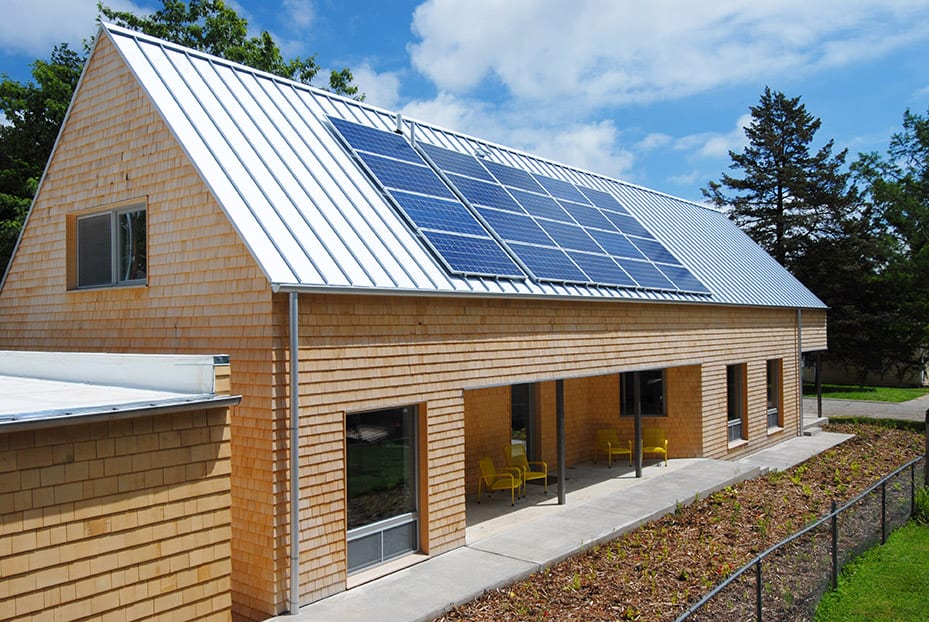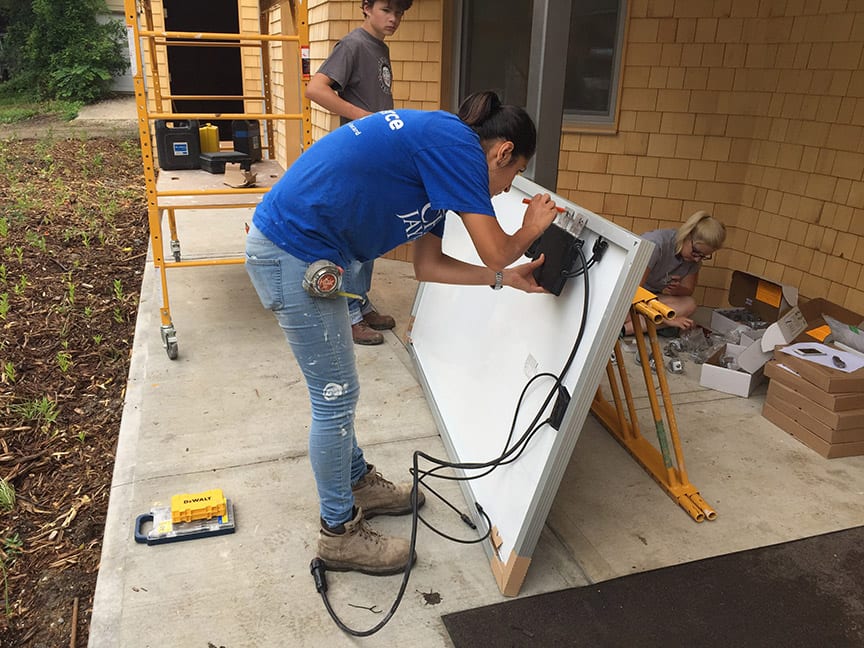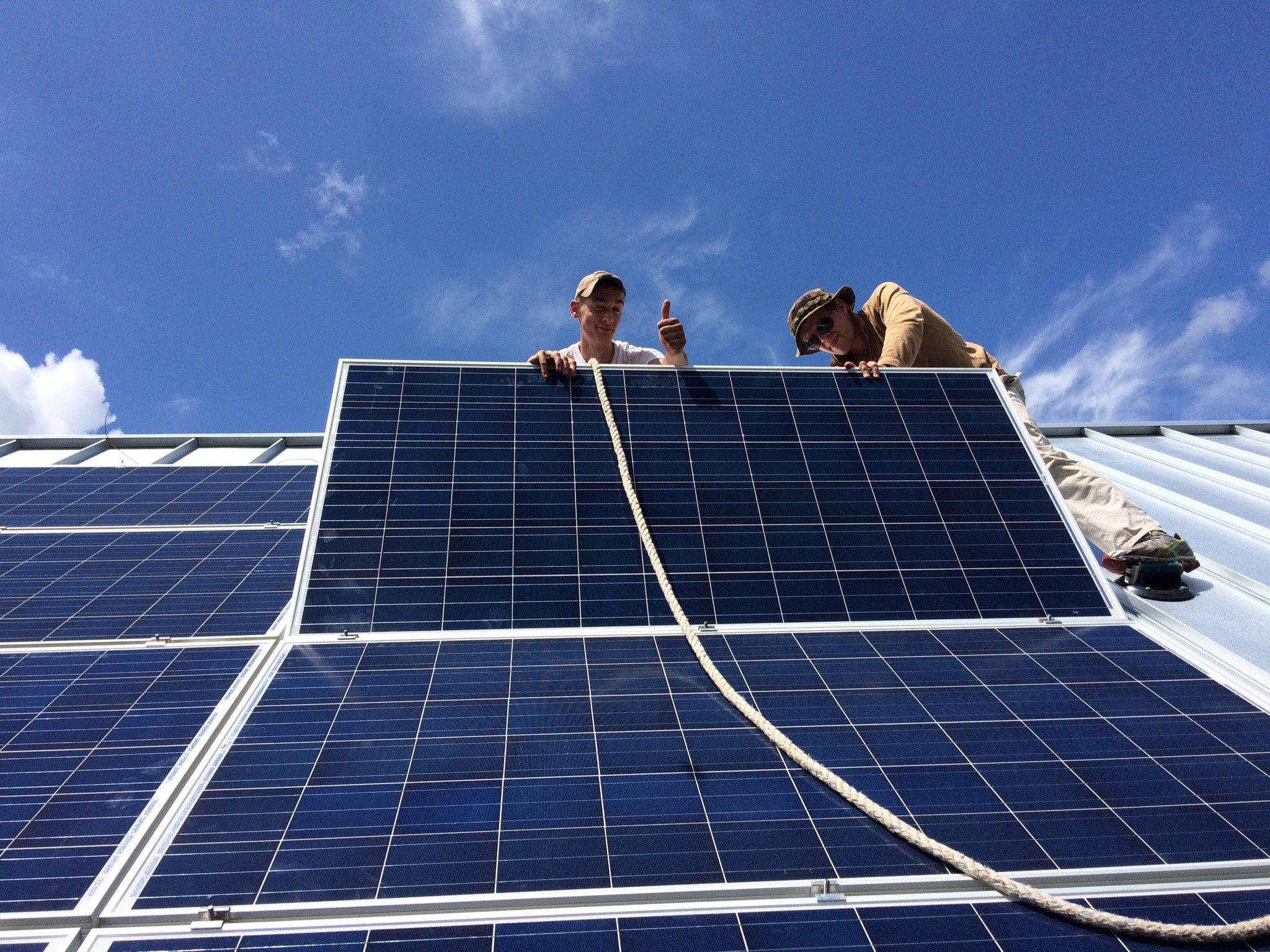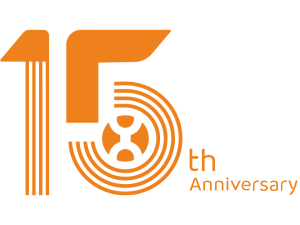Powering old homes with solar is only half the renewable-energy equation.
Designing and building new homes that make the most of that renewable power – achieving ultra-efficient “Net Zero” construction, and beyond – is the next frontier for sustainable living.
American graduate students in the University of Kansas Department of Architecture, Design and Planning are pushing construction into the future through Studio 804, a nonprofit organization that tests their drafting-board skills against real-world challenges.
Where conventional construction ends, the Studio 804 program begins.

“If a group full of students who have never worked construction or designed and built a project can accomplish these highly sustainable buildings, it shows what the industry as a whole should be capable of,” said Taylor Pickman, now in his fifth and final year in the colloquially known “M-Arch” program. “We like to think we’re setting an example in that sense.”
Their most recent success: the East Lawrence Passive House, an innovative solar home set among the tree-lined streets of a quintessential college town, a mix of modest historic homes, and even the mansions of nineteenth century industrial tycoons.
Outside, the home was designed to fit in with the scale and aesthetics of the neighborhood, while maximizing square footage on a prominent but narrow corner lot. Cut-cedar siding offers a look familiar to the neighborhood while carrying a low carbon footprint. Generous windows maximize passive solar potential.
Inside, the home boasts a laundry list of energy-saving features. A triple-thick blanket of insulation achieves dramatic “R” values, while an advanced air barrier wrap further reduces heat loss. A low-energy HVAC system and energy-recovery ventilator supplies fresh air without energy waste, while the plumbing includes an insulated hot-water recirculation system for more efficiency still.
The home meets the rigorous standards of the LEED Platinum, Net Zero and Passive House certification programs – a trifecta for sustainable construction.
Net Zero, for instance, requires that all heating, cooling and electrical needs must be met through energy-conserving design features and onsite renewable sources.
That’s where solar comes in. The East Lawrence home features a 6kW rooftop system powered by 20 Trina modules and 10 APsystems YC500 dual-module microinverters.
Studio 804 students approached APsystems for help with the project, and the Seattle-based solar technology company offered the microinverter units as a donation.

“These students are really leading the way forward for energy-efficient design and construction,” said Thomas Nelson, APsystems vice president for sales, USA. “As a leader in innovative solar technology, we were glad to sign on to the project and be included in this showcase home.”
Pickman said microinverters represent “a huge innovation” in the solar field, helping students meet their project goals even without real experience as solar installers.
“I have to say that those microinverters were very simple to install, very simple to work with and very simple to use,” Pickman said. “We had more trouble getting the panels up onto the roof than we ever did working with the micro inverters.”
Bigger, more ambitious projects
KU’s Studio 804 program is committed to the research and development of sustainable, affordable, and inventive building solutions, from the standards of human comfort to the nature of urban spaces.
Two education tracks are offered: a three-year Master of Architecture program for students who already hold undergraduate degrees, or a five-year program that melds both undergraduate and graduate studies and also culminates in the master’s degree.
The final year is a rigorous practicum in which students tackle all aspects of design and construction: from site selection to negotiating building and zoning codes, to working with neighborhood associations and project engineers, to pouring concrete and pounding nails.
“A lot of our projects are speculative, so we are also in charge of making sure the project gets sold,” Pickman said.
To date the studio has completed seven LEED Platinum buildings and two with Passive House certification, meeting the most rigorous environmental standards for materials and construction.
Solar has become a regular feature of Studio 804 work, Pickman said, because it is one of the most effective means of achieving onsite energy production in the Midwest.
“Solar is relatively simple and it functions relatively well with different housing configurations,” he said. “And every year the technology gets better, so every year, we can demonstrate that technology as well.”
Studio 804 produces one building per year, and they keep getting more ambitious.
Twenty years ago, the first Studio 804 project put a simple metal roof over a historic farmhouse. Two years ago, students designed and built a lecture hall and auditorium addition to Marvin Hall, a treasured, 1908-vintage engineering building on the University of Kansas campus.

Pickman said their next challenge may be achieving the WELL Building standard, which considers interior design and the ergonomics of the living spaces and fixtures – anything that will “reduce wear and tear on the human body.”
“Every year we set slightly different goals,” Pickman said, from building scale to advanced materials and construction and renewable energy techniques.
“And great architecture, or at least very good architecture,” he added. “There’s not a lot of it Kansas.”
East Lawrence Passive House
East Lawrence, Kansas, USA
Designer/installer: Studio 804, graduate students in the University of Kansas Department of Architecture, Design and Planning
System output: 6kW
No. of modules: 20
Module type: Trina TSM-290
Microinverters: APsystems YC500 dual-module
No. of microinverters: 10
croinverters: 10
 AI Navigates the Future of Solar & Energy Storage: APsystems Builds a Diverse Smart Energy EcosystemJune 8, 2025 - 11:58 pm
AI Navigates the Future of Solar & Energy Storage: APsystems Builds a Diverse Smart Energy EcosystemJune 8, 2025 - 11:58 pm APsystems Celebrates 15 Years of Solar LeadershipMarch 24, 2025 - 1:05 am
APsystems Celebrates 15 Years of Solar LeadershipMarch 24, 2025 - 1:05 am Innovation & Collaboration: APsystems Global Marketing Summit 2025March 11, 2025 - 8:21 pm
Innovation & Collaboration: APsystems Global Marketing Summit 2025March 11, 2025 - 8:21 pm APsystems continues to illuminate lives with Extend the DayNovember 17, 2023 - 5:44 pm
APsystems continues to illuminate lives with Extend the DayNovember 17, 2023 - 5:44 pm 10 Million Solar Panels Served Worldwide with APsystems MLPE DevicesOctober 16, 2023 - 4:34 pm
10 Million Solar Panels Served Worldwide with APsystems MLPE DevicesOctober 16, 2023 - 4:34 pm


University of Kansas (USA) architecture students take solar construction into the future
/in Article, General NewsPowering old homes with solar is only half the renewable-energy equation.
Designing and building new homes that make the most of that renewable power – achieving ultra-efficient “Net Zero” construction, and beyond – is the next frontier for sustainable living.
American graduate students in the University of Kansas Department of Architecture, Design and Planning are pushing construction into the future through Studio 804, a nonprofit organization that tests their drafting-board skills against real-world challenges.
Where conventional construction ends, the Studio 804 program begins.
“If a group full of students who have never worked construction or designed and built a project can accomplish these highly sustainable buildings, it shows what the industry as a whole should be capable of,” said Taylor Pickman, now in his fifth and final year in the colloquially known “M-Arch” program. “We like to think we’re setting an example in that sense.”
Their most recent success: the East Lawrence Passive House, an innovative solar home set among the tree-lined streets of a quintessential college town, a mix of modest historic homes, and even the mansions of nineteenth century industrial tycoons.
Outside, the home was designed to fit in with the scale and aesthetics of the neighborhood, while maximizing square footage on a prominent but narrow corner lot. Cut-cedar siding offers a look familiar to the neighborhood while carrying a low carbon footprint. Generous windows maximize passive solar potential.
Inside, the home boasts a laundry list of energy-saving features. A triple-thick blanket of insulation achieves dramatic “R” values, while an advanced air barrier wrap further reduces heat loss. A low-energy HVAC system and energy-recovery ventilator supplies fresh air without energy waste, while the plumbing includes an insulated hot-water recirculation system for more efficiency still.
The home meets the rigorous standards of the LEED Platinum, Net Zero and Passive House certification programs – a trifecta for sustainable construction.
Net Zero, for instance, requires that all heating, cooling and electrical needs must be met through energy-conserving design features and onsite renewable sources.
That’s where solar comes in. The East Lawrence home features a 6kW rooftop system powered by 20 Trina modules and 10 APsystems YC500 dual-module microinverters.
Studio 804 students approached APsystems for help with the project, and the Seattle-based solar technology company offered the microinverter units as a donation.
“These students are really leading the way forward for energy-efficient design and construction,” said Thomas Nelson, APsystems vice president for sales, USA. “As a leader in innovative solar technology, we were glad to sign on to the project and be included in this showcase home.”
Pickman said microinverters represent “a huge innovation” in the solar field, helping students meet their project goals even without real experience as solar installers.
“I have to say that those microinverters were very simple to install, very simple to work with and very simple to use,” Pickman said. “We had more trouble getting the panels up onto the roof than we ever did working with the micro inverters.”
Bigger, more ambitious projects
KU’s Studio 804 program is committed to the research and development of sustainable, affordable, and inventive building solutions, from the standards of human comfort to the nature of urban spaces.
Two education tracks are offered: a three-year Master of Architecture program for students who already hold undergraduate degrees, or a five-year program that melds both undergraduate and graduate studies and also culminates in the master’s degree.
The final year is a rigorous practicum in which students tackle all aspects of design and construction: from site selection to negotiating building and zoning codes, to working with neighborhood associations and project engineers, to pouring concrete and pounding nails.
“A lot of our projects are speculative, so we are also in charge of making sure the project gets sold,” Pickman said.
To date the studio has completed seven LEED Platinum buildings and two with Passive House certification, meeting the most rigorous environmental standards for materials and construction.
Solar has become a regular feature of Studio 804 work, Pickman said, because it is one of the most effective means of achieving onsite energy production in the Midwest.
“Solar is relatively simple and it functions relatively well with different housing configurations,” he said. “And every year the technology gets better, so every year, we can demonstrate that technology as well.”
Studio 804 produces one building per year, and they keep getting more ambitious.
Twenty years ago, the first Studio 804 project put a simple metal roof over a historic farmhouse. Two years ago, students designed and built a lecture hall and auditorium addition to Marvin Hall, a treasured, 1908-vintage engineering building on the University of Kansas campus.
Pickman said their next challenge may be achieving the WELL Building standard, which considers interior design and the ergonomics of the living spaces and fixtures – anything that will “reduce wear and tear on the human body.”
“Every year we set slightly different goals,” Pickman said, from building scale to advanced materials and construction and renewable energy techniques.
“And great architecture, or at least very good architecture,” he added. “There’s not a lot of it Kansas.”
East Lawrence Passive House
East Lawrence, Kansas, USA
Designer/installer: Studio 804, graduate students in the University of Kansas Department of Architecture, Design and Planning
System output: 6kW
No. of modules: 20
Module type: Trina TSM-290
Microinverters: APsystems YC500 dual-module
No. of microinverters: 10
croinverters: 10
EMA app upgraded for APsystems microinverter users
/in General NewsThe EMA App lets homeowners track the performance of their APsystems solar array in real time, more quickly and conveniently than ever.
See comprehensive system data including power output by day, month, year or lifetime of the array. EMA App also calculates energy savings based on price per kilowatt hour, and shows environmental benefits in gallons of gasoline, trees and carbon emissions.
All data is displayed through an easy-to-use graphical interface.
EMA App is available for iPhone and iPad through the Apple iTunes store, or through the APsystems website.
VIDEO: Learn the APsystems EMA and ECU monitoring system basics
/in General News, VideoFrom system setup to performance tracking, a robust monitoring package is essential to installers and end users alike.
The Energy Communication Unit and EMA software from APsystems offer this powerful but easy-to-use monitoring and analysis at every step.
Chris Barrett, APsystems USA director of technical services, demonstrated our advanced user interface at this year’s Solar Power International North America show, and you can see the video now.
Find out how installers can pre-configure the ECU-4 gateway with microinverter serial numbers for plug-and-power at the job site, and how customers can easily track their array’s performance in real time from their computer or device.
See the EMA and ECU Basics video on our APsystems Youtube channel here, along with more videos highlighting our installations and products.
Big News: the A+ Rewards Program is here!
/in A+ Rewards, General NewsAPsystems and its A+ Rewards Program offer an unbeatable deal on advanced microinverter technology for installers.
For every 10 YC500 microinverters you purchase from a participating APsystems Distribution Partner, receive a free Energy Communication Unit (ECU) or a free YC500 microinverter. This offer varies by region; contact your distributor for details.
That’s right: Every 10 APsystems YC500 microinverters you purchase through Oct. 31, 2015, will earn a free device. Your A+ Rewards free items will be sent with your order, with a minimum order of 10 YC500 microinverters to qualify.
There’s never been a better time to bring APsystems microinverters to your customers. Contact your participating APsystems distributor for more information on the A+ Rewards program, and place your order today for prompt fulfillment.
Global solar technology leader APS rebrands as APsystems
/in General News, Press ReleasesFOR IMMEDIATE RELEASE
JIAXING, CHINA – APS, a global leader in solar technology, is now APsystems.
The brand refinement highlights the company’s commitment to powerful alternative energy solutions, and its evolution from a product-oriented portfolio to a whole-systems innovator.
The phrase “Altenergy Power,” a nod to the company’s original legal name, will appear beneath APsystems in the company’s new mark.
“Our company has earned a high profile in the solar marketplace, and we want to emphasize our commitment to alternative energy through our new brand,” said Zhi-Min Ling, APsystems co-founder, CEO and president, global operations. “Our range of product offerings is growing each year, and the new name also highlights our evolution toward whole-systems solutions.”
The new positioning follows the company’s strong growth and industry recognition in the U.S. and international solar markets over the past two years.
APsystems is headquartered in Jiaxing, China, and Seattle, USA, with regional offices in Europe and Australia, and Shanghai, China for global marketing and sales.
The company was founded in Silicon Valley in 2009 with a single product offering, a first-generation microinverter.
An ongoing commitment to research and development, engineering and technology innovation has created a robust module-level power electronics (MLPE) solutions portfolio. The company’s technology is also featured in integrated PV solutions by other solar industry leaders.
More than half of the APsystems workforce is involved in R&D engineering, underscoring the focus on constant product advancement and innovation.
The company’s flagship product, the YC500 microinverter, broke ground among MLPE offerings as the most powerful unit to handle two solar modules simultaneously, simplifying PV system design and significantly lowering installation costs on a per-watt basis.
More recently, the YC1000 microinverter entered the solar market as an innovative, purpose-designed unit for commercial applications. The fourth-generation technology offers true 3-phase (balanced AC) output and handles up to four modules per unit, bringing microinverter technology to the untapped commercial segment for the first time.
The microinverters have been successfully deployed on six continents.
“Our exclusive microinverter technology has proven itself powerful, reliable and attractive in the solar marketplace, in both residential and commercial installations worldwide,” said Wesley Tong, who is responsible for APsystems corporate strategy and new business development in global markets. “With our dedication to research and development, our portfolio of innovative solar solutions will continue to see new offerings of benefit to both consumers and the environment.”
APsystems products are designed around a flexible and powerful Field Programmable Gate Array (FPGA) integrated circuit, giving the company a significant competitive advantage in design, manufacturing, reliability and cost effectiveness.
The company’s microinverter line is programmable to any grid standard anywhere in the world, and is backed by industry-leading warranties and support.
See APsystems.com for information on the company’s worldwide operations, with links to offices in each regional market.
—-
APsystems is a worldwide leader in the development, manufacturing and marketing of alternative energy solutions based on its own proven, leading-edge technology. APsystems is headquartered Jiaxing, China, and Seattle, USA, with regional offices in Europe and Australia.
A letter to our solar partners: APS becomes APsystems
/in Events, General News, Press ReleasesIt’s been just six years since APS was a Silicon Valley startup – and how far we’ve come in that short time. Founded with the goal of bringing the most advanced microinverter technology to the solar PV market, we’ve passed one milestone after another en route to ranking no. 2 in global market share among top microinverter suppliers by shipments in 2013 (source: GTM Research). Last year was even stronger still.
And we’re not slowing down – demand for our microinverter line is growing month over month in all markets. As we look toward even greater achievements on the horizon, we’re pausing just long enough to reflect on who we are and what we’re about.
With that reflection comes a refinement of our brand: APS will become APsystems.
The new trade name highlights our commitment to powerful alternative energy solutions, and our evolution from a product-oriented portfolio to a whole-systems innovator. The phrase “Altenergy Power,” a nod to the company’s original legal name, will appear beneath APsystems in our new mark.
The new name will launch August 31st. With the brand refinement, we’re also launching a new website, apsystems.com, an online nexus for our worldwide operations with links to offices in each regional market. We hope you’ll visit the site and see the APsystems big picture.
What’s next? Big things. We’re making a strong push into new markets worldwide, and rolling out even more powerful solutions to accommodate new and emerging technologies. Expect more announcements throughout the coming year.
Our name has changed, but our values are the same. We remain passionate about solar power and advancing our clean, renewable energy future. We offer maximum value to customers through excellence of products, pricing and support. Honesty, professionalism and teamwork define our company. Add them up, and we believe an informed customer will always choose APsystems.
We’re excited about this moment, and we want to share the news with our valued solar partners like you. We look forward to a bright future together.
Kindest regards,
Andrew Lonseth
President, U.S. Operations
APS Microinverter technology featured at Dargaville, NZ, solar show
/in Events, General NewsAPS partner MPower exhibited the APS YC500 and YC1000 microinverters at the popular Dargaville, New Zealand, solar show in late February.
Designed for residential applications, the YC500 handles two PV modules independently, while the 3-phase, 4-module YC1000 is specially designed and built for commercial applications.
The Dargaville event showcased APS Microinverters as mature solar technology, with the line seeing widespread adoption and application in the global marketplace.
MPower is a valuable partner for APS, and a leading provider of innovative and dependable power solutions in Australia, New Zealand, and across the South Pacific. With a company history dating back 100 years, MPower offers a comprehensive range of power solutions and products.
APS Microinverter products are second to none in functionality, efficiency and durability. Through partnerships with leading solar providers like MPower, APS is simplifying and lowering the cost of PV system ownership for both residential and commercial customers worldwide.
APS YC1000 microinverter enters the Australia market
/in General News, Press ReleasesSolar power is widely used in Australia and many families have installed PV system on their roofs. APS is proud to be first among microinverter suppliers in the Australian market, providing the best and most economical products available.
The YC1000 is the world’s first true 3-phase microinverter (balanced AC output) and offers a proven solution for commercial-scale PV systems. The 1:4 microinverter-to-module ratio significantly lowers balance of system costs.
Unlike other microinverter products entering the commercial segment, the YC1000 line requires no step-up or step-down transformer to operate. Add-on transformers reduce system efficiency and add thousands of dollars in balance-of-system costs – issues the YC1000 microinverter are specifically designed to avoid.
The YC1000 microinverter connects directly to low-voltage DC modules, eliminating the possibility of “arc” fires from high-voltage arrays typical of conventional string inverter systems. The unit also offers revolutionary trunk cabling, eliminating the need for branch cables and resolving “landscape vs. portrait” configuration issues.
Conventional “string” systems only operate as efficiently as the lowest-performing module, meaning reduced output from a shadow or leaf on one module cuts output across the whole array. The YC1000 offers module-level MPPT, increase the array performance.
Using the YC1000 simplifies system design, increases system flexibility, saves the cost of installation and maintenance, and also shortens setup time. It is the best solution for 3-phase residential and commercial systems for the Australian market.
Through the APS Energy Communication Unit and Energy Monitoring and Analysis software, the user can follow the performance of their array in real time and also see historical output data. Precise monitoring lets the user pinpoint the location and nature of any system issues and get precise guidance for necessary maintenance, all within our user-friendly graphic interface.
APS now offers the EMA 2.0 with even more detailed system tracking. Coming soon: the EMA APP for handheld devices, bringing even more convenient monitoring to APS Microinverter end users.
YC1000-3-208 microinverter earns CEC certification
/in General News, Press ReleasesThe new YC1000-3-208 microinverter from APS has earned CEC certification.
The California Energy Commission listing is a key benchmark of solar product efficiency and quality, and qualifies equipment for use and financial incentives under the California Solar Initiative. The CEC standard is also recognized throughout the western U.S. solar market.
The YC1000-3-208 microinverter earned a 94.5 percent efficiency rating from the CEC board.
“We’re very pleased to see the YC1000-3-208 earn the CEC listing,” said Paul Barlock, APS U.S.A. Senior Vice President. “APS really has broken new ground with this unit, the first microinverter purpose-designed and built for the commercial segment. This is the innovation the industry has been waiting for.”
A sister unit that operates at 277/480 grid voltage, the APS YC1000-3-480, earned the CEC listing in November 2014.
The YC1000 microinverter line offers true 3-phase output and handles four PV modules per unit. The 1:4 microinverter-to-module ratio significantly lowers balance of system cost.
Unlike other microinverter products entering the commercial segment, the YC1000 line requires no step-up or step-down transformer to operate. Add-on transformers reduce system efficiency and add thousands of dollars in balance-of-system costs.
“Having to add a transformer is where other offerings in the market fail,” said Ryan Simpson, Senior Director of Sales and Program Management for APS America.. “With the YC1000 microinverter line, commercial system designers now have an advanced, all-in-one solution that wins on both efficiency and cost.”
The YC1000 microinverter connects directly to low-voltage DC modules, eliminating the possibility of “arc” fires from high-voltage arrays typical of conventional string inverter systems. The unit also offers revolutionary trunk cabling, eliminating the need for branch cables and resolving “landscape vs. portrait” configuration issues.
For YC1000-3 product information and data sheets, see www.apsamerica.com.
For information on the California Solar Initiative and CEC product certification, see www.gosolarcalifornia.ca.gov.
APS is a worldwide leader in the development, manufacturing and marketing of microinverters based on our proprietary, leading-edge solar technology. Representing APS in the U.S. market, APS America. is based near Seattle.
APS ranked No. 2 in global market share among top microinverter suppliers by shipments in 2013 (source: GTM Research).
APS Microinverters meet CEC requirements of IEC 62109-1 and IEC 62109-2
/in General NewsAPS Microinverters fully comply with new requirements for safety and quality that will go into effect in Australia in 2015.
Module-level power electronics must be certified to meet IEC 62109-1 and IEC 62109-2 after July of this year, according to the Clean Energy Council of Australia and the SAA Approvals testing laboratories.
APS Microinverter products have been certified to meet the CEC standards since August 2013, the first microinverter products to meet the rigorous Australian requirements.
IEC 62109-1 and IEC 62109-2 certification governs inverters used in photovoltaic systems to ensure uniform technical standards and appropriate safety benchmarks. The codes define the minimum requirements for product design and manufacture for protection against electric shock, energy, fire, mechanical and other hazards.
Australia is a key market for APS globally. All APS Microinverters are engineered and manufactured to the highest standards of safety and reliability, and APS will spare no effort to maintain the quality of products and services to ensure Australia’s green energy development.